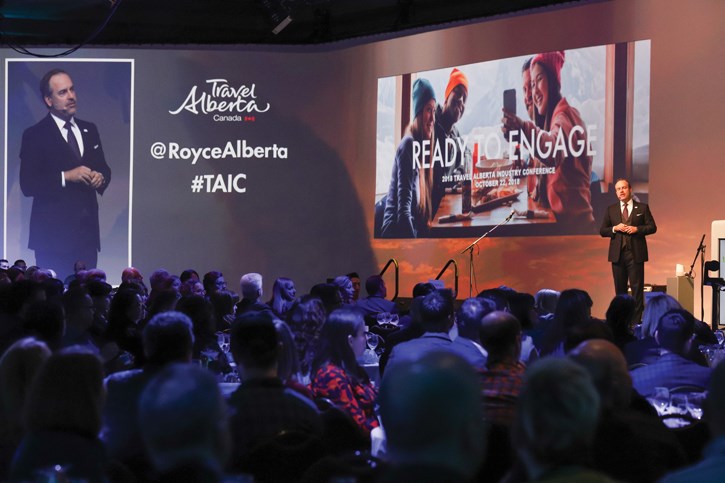BOW VALLEY – Travel Alberta continues to push towards increasing tourism spending in the province to $10 billion by 2020 and it has its eyes on international travellers as the best way to achieve that goal.
In 2017, the tourists’ spent $8.5 billion in the province, up $300 million from the year before, leaving a $1.5 billion gap for the destination marketing organization to bridge.
“We choose to see this as an opportunity; it is not a gap it is a challenge,” said Travel Alberta CEO Royce Chwin at the recent industry conference in Banff.
“We can in fact meet and exceed that and in doing so we can collectively demonstrate that focused, sustained investment in destination development and promotion will deliver these results.”
For Chwin, the delivery on that objective is found in the potential that international travellers represent, as they make up six per cent of tourists in the province but 25 per cent of the spending. International travellers spend six times more than regional visitors in the province.
The overall number of international tourists has increased from four per cent in previous years, and represents $2 billion in spending – making the international visitor a prime focus for growth in the industry. Industry experts credit the increase to more travel routes into the province, lower cost of air fare and a better global economy.
“It is also evidence of our ability to compete,” Chwin said. “We are going after the right kind of travellers with the right kind of experiences, in the right kinds of markets and your collective efforts to market to them.”
Canadian tourism is also seeing significant visitation and spending with Banff and Canmore contributing to that success.
In the first six months of 2018, Canada welcomed a record 8.6 million international tourists, an increase of 1.6 per cent over the same period in 2017, according to most up to date statistics.
Officials say tourism activities directly accounted for more than $18 billion of Canada’s GDP, an increase of more than six per cent over the first half of 2017 and supports about 1.8 million jobs from coast to coast to coast.
Mélanie Joly, Canada’s federal tourism minister, said tourism around the world is growing at a rate of four per cent a year, making it one of the most important industries for Canada.
“Our job together is to make sure we can seize the growth potential in the world right now,” she said at the conclusion of federal-provincial-territorial meeting of ministers in Calgary on Oct. 17.
“Tourism is also very labour intensive. When we look at the data, one out of 10 jobs in this country are in the tourism sector and in Alberta there are 200,000 jobs linked to the tourism sector.”
Darren Reeder, executive director of Banff Lake Louise Hospitality Association (BLLHA), said 2018 has been a strong year for tourism in Banff and Lake Louise, slightly down from last year.
“We see a trend of visitors coming to Banff and Lake Louise more into the spring, fall and winter, which is very positive as we have lower occupancy during those times, and lots of capacity and equally appealing experiences as the summer,” he said.
“A 2016 tourism impact study for Banff, Jasper and Canmore confirmed that the economic impact of tourism in Banff amounted to $1.4 billion.”
Reeder said national parks generate nearly $5 billion per year in economic activity and help employ nearly 65,000.
Even at the federal level, the potential of international visitation to grow economic activity is a focus. China, for example, is Canada’s third largest source of international tourists and 2018 was the year of travel between the two countries.
Canada welcomed over 300,000 tourists from China in the first half of 2018, an increase of more than nine per cent over the same period last year.
The strategy that Travel Alberta has undertaken to reach international markets includes targeted marketing and promotion in specific countries where there is potential for growth like China.
Chwin added tourism needs to be mobile relevant and today’s travellers need to have frictionless access to experiences in Alberta to meet their needs.
“Over the last three years, we have been reshaping our organization to better understand and more importantly take advantage of this power shift,” he said.
“Tourism business growth is rebounding, or continuing to grow in a positive outward trajectory not just here in the Rockies, but in many parts of our province.”
Rocky Mountain destinations like Canmore, Banff and Jasper are a huge draw for visitation, but Chwin said it is important to be aware of the possibility of over-tourism.
He acknowledged that focusing on slower seasons and different regions of Alberta is critical for the tourism strategy to help address that concern.
It is something he said local agencies have been addressing.
“I would like to applaud Parks Canada and Banff Lake Louise Tourism and all the partners who have done a ton of work to help protect the park and the guest experience while achieving record visitation – 4.1 million visitors were here last year,” Chwin said.
“We have to protect our reputation … what we don’t want to have happen is run into same scenario as Barcelona or Venice.
“Over tourism will damage our brand, it will damage the perception of our province and people will not come here because of those reasons ... Thankfully we proactively continue to make this a priority to build sustainable tourism in Alberta.”
Chwin said the global tourism industry is worth more than $7 trillion annually and continues to grow.He said it is for that reason that destinations will continue to compete for a piece of the pie and that includes Alberta.




